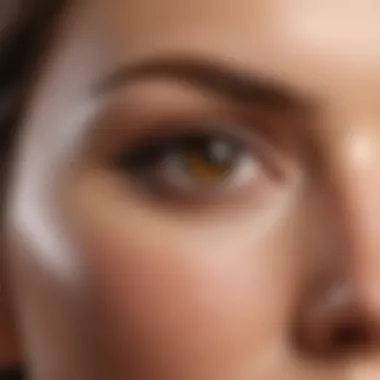A Comprehensive Guide to Bikini Wax: Steps and Considerations


Intro
Bikini waxing is a common practice among women seeking to maintain personal grooming standards. This procedure not only enhances appearance but also contributes to comfort during warmer months when swimwear becomes a focal point. Understanding the intricacies of bikini wax can significantly impact the experience, whether you are a first-time receiver or looking to improve your technique.
Proper preparation is essential for a successful bikini wax. Here, we will proceed to explore the steps involved in the process, considerations for a better experience, and aftercare tips that ensure both comfort and lasting results. Through this comprehensive guide, you will gain valuable insights to facilitate the waxing process and elevate your grooming routine.
As we delve into this subject, it is important to note that individual preferences and skin types play a crucial role in how one might approach their bikini waxing journey. There are various options available in terms of styles and techniques, and understanding these can assist in making informed decisions. The guide aims to equip you with both knowledge and confidence, making your waxing experience smooth and effective.
Understanding Bikini Waxing
Bikini waxing is an essential grooming technique for many women, often leading to a sense of satisfaction and personal confidence. Understanding bikini waxing helps women make informed decisions about their grooming habits.
The significance of this topic cannot be overstated, as it encompasses not only the technical aspects of the procedure but also the emotional and physical considerations involved.
Definition of Bikini Wax
Bikini wax is a form of hair removal that targets the bikini line and surrounding areas. This method involves applying warm wax to the skin, then removing it quickly to pull hair out from the root. The objective is to achieve a clean and smooth appearance, particularly when wearing swimwear or fitted clothing.
Benefits of Bikini Waxing
The benefits of bikini waxing extend beyond aesthetics.
- Long-lasting results: Unlike shaving, which may only last a few days, bikini waxing can keep skin hair-free for several weeks.
- Finer regrowth: Over time, frequent waxing can lead to finer and softer hair regrowth, making future sessions less painful.
- Exfoliation: Waxing also exfoliates the skin, removing dead skin cells in the process. This can result in a healthier-looking complexion.
Different Types of Bikini Waxes
Bikini waxes come in several variations, each catering to different preferences and levels of hair removal.
Basic Bikini Wax
A basic bikini wax shapes the edges of hair that extends outside the typical bikini line. This procedure removes unwanted hairs, making swimsuits fit more comfortably. It's a very popular choice for those new to waxing since it is relatively quick and less intense than deeper wax types. The main feature of basic bikini wax is simplicity, making it an approachable choice for many first-timers.
French Bikini Wax
The French bikini wax takes the basic style a step further. It removes hair from the sides and the top while leaving a strip down the center. This type offers a more refined look without complete hair removal. This is beneficial for women wanting a less dramatic change while still enjoying a polished appearance. Many find that the French wax strikes a balance between bold and subtle.
Brazilian Wax
A Brazilian wax removes almost all hair from the bikini area, including front, back, and everything in between. This style is considered the most comprehensive and is favored for its clean finish. The key characteristic of Brazilian waxing is full hair removal, resulting in a smooth surface. Although it may seem daunting, many prefer this option for various reasons, including feeling cleaner and more confident. However, the technique requires a higher pain tolerance due to the extent of hair removal involved.
Understanding these types allows women to select the method that best aligns with their personal grooming needs, creating an informed approach to bikini waxing.
Preparation for Bikini Waxing
Preparation is critical prior to undergoing a bikini wax. It sets the foundation for a smooth and effective waxing experience. Proper preparation helps to ensure that the process is as comfortable as possible, reduces the likelihood of adverse skin reactions, and enhances the overall effectiveness of the treatment. Understanding the physical and mental aspects of preparation can bring significant benefits.
Physical Preparation
Hair Length Considerations
Hair length plays a crucial role in the bikini waxing process. Ideally, the hair should be about a quarter of an inch long. This length allows the wax to grip the hair effectively, resulting in a cleaner and smoother outcome. If the hair is too short, the wax may not adhere adequately, and if it's too long, it can lead to increased pain during removal.
Ensuring the right hair length may seem trivial, but it significantly impacts the efficiency of the waxing. This is a beneficial practice for both novices and experienced individuals. The unique aspect is that hair length directly influences the comfort level during waxing. Properly prepared hair means fewer incidents of hair breakage or skin irritation.
Exfoliation Techniques
Exfoliation is another important physical preparation step. By sloughing away dead skin cells, exfoliation helps prevent ingrown hairs and allows for a smoother surface. Typically, gentle methods such as sugar scrubs or chemical exfoliants are recommended a few days prior to waxing.
The key characteristic of exfoliation is that it prepares the skin for waxing, making for a better overall experience. A benefit of this technique is a reduction in irritation post-waxing, offering lasting results. However, it is crucial not to over-exfoliate, as this can lead to skin sensitivity. Finding the balance is essential for achieving optimal wax readiness.
Mental Preparation


Setting Expectations
Setting expectations before a bikini wax is vital. Understanding what the process entails and anticipating the sensations involved can alleviate anxiety. Preparing mentally helps individuals feel more in control, which can significantly improve the experience.
The key characteristic of setting expectations is awareness. Knowing how long the procedure will take and what to expect in terms of discomfort can make the experience less daunting. This step is crucial, particularly for those new to waxing. One potential downside could be misinformation, which may lead to unrealistic expectations. Hence, seeking accurate information is beneficial.
Choosing the Right Time
Choosing the right time for a bikini wax affects both comfort and effectiveness. It is advisable to schedule waxing when your body is least likely to be irritable. For many, that may be a week after their menstrual cycle, as hormonal fluctuations can heighten pain sensitivity.
This characteristic makes timing strategically important. Making an informed decision can enhance comfort during the process. It is worth noting that waiting for a suitable time can sometimes lead to less frequent appointments, which might not suit everyone's schedule.
Ultimately, careful preparation can transform your bikini waxing experience. Prioritize your physical and mental readiness to maximize comfort and results.
Essential Tools and Products
Understanding the essential tools and products for bikini waxing is crucial for ensuring a smooth experience. Having the right equipment can make the difference between a satisfactory outcome and one that leads to dissatisfaction or discomfort. This section outlines the various types of wax, pre-wax products, and post-wax products, providing an overview of their roles and advantages.
Types of Wax
Soft Wax
Soft wax is a popular choice for bikini waxing due to its ease of use and effectiveness. This wax is typically applied thinly and adheres well to the skin, capturing fine hair effectively. The major characteristic of soft wax is its ability to pull the hair from the root while also helping to exfoliate the skin. This can lead to smoother results and faster application.
The unique feature of soft wax lies in its application process. It requires strips for removal, which can save time during the procedure. Some benefits include quicker processing time and effective hair removal. However, it can be painful for those with sensitive skin, as it adheres to both hair and skin. This might cause irritation or redness.
Hard Wax
Hard wax is famous for its gentleness and suitability for sensitive areas, including the bikini line. It hardens upon cooling and can be removed without the use of strips, making it a less painful option for some users. The important characteristic of hard wax is its formulation, which typically allows it to grip only the hair, minimizing skin irritation.
Hard wax is highly beneficial for its ability to target thicker hair and can often lead to a less painful experience compared to soft wax. Its unique feature is in its efficiency, as it can be pulled away from the skin without removing layers of skin tissue. However, it can require a bit more skill to apply correctly and may take longer to learn for those new to waxing.
Pre-Wax Products
Pre-Wax Cleansers
Pre-wax cleansers are essential to prepare the skin for waxing. These products ensure that the waxing area is free of oils, lotions, and dirt, which can impact the effectiveness of wax application. Their key characteristic is the ability to cleanse without irritating the skin. A clean surface allows the wax to adhere properly to the hair, enhancing the overall waxing experience.
The unique feature of pre-wax cleansers is their formulation. They are often alcohol-free and soothing, designed to prepare the skin without causing irritation. The advantage here is clearer, smoother skin that leads to better results. Neglecting to use a pre-wax cleanser can lead to poor waxing outcomes.
Skin Soothing Creams
Skin soothing creams play an important role before and after the waxing process. These creams can help calm the skin and reduce sensitivity. Their major characteristic is the moisturizing properties that can prepare the skin. Many of these creams contain natural ingredients known for their soothing effects.
Using soothing creams is beneficial as they can diminish discomfort and redness associated with waxing, enhancing the overall experience. They also create a protective barrier that can lessen the impact of wax on the skin. However, one must ensure that the product does not interfere with the wax's adhesion during the process.
Post-Wax Products
Aloe Vera Gel
Aloe vera gel is a well-known remedy for skin irritation and is especially valuable after waxing. Its hydrating and anti-inflammatory properties help soothe any discomfort that may arise. The key characteristic of aloe vera gel is its natural composition and cooling effect. This makes it a preferred choice for post-wax care.
The unique feature of aloe vera gel is its ability to provide immediate relief while also offering long-term skin benefits. Consistent use can help minimize redness and promote healthy skin recovery post-wax. Still, some individuals may need to check for allergies to aloe before use, as reactions could diminish its benefits.
Anti-Inflammatory Creams
Anti-inflammatory creams are pivotal after the waxing process. They help in reducing swelling and redness, often containing ingredients that calm irritated skin. Their key characteristic is quick relief of discomfort, making them especially effective for sensitive skin types.
These creams are beneficial because they provide a protective effect, helping the skin to recover from any irritation. They often contain soothing ingredients like chamomile or calendula. However, care must be taken to choose products that are non-comedogenic to avoid clogging pores post-wax.
Overall, being equipped with the right tools and products is fundamental for a successful bikini waxing experience. Investing in quality materials can lead to improved outcomes, while proper pre and post-care promotes skin health.


The Step-by-Step Bikini Wax Process
Bikini waxing may seem like a straightforward task, but it requires precision and care. Understanding the step-by-step process is essential for optimal results and minimizing discomfort. Each phase not only prepares the skin but also ensures a clean and smooth finish. Following these steps can enhance the overall experience and reduce potential complications.
Step One: Cleanse the Area
Before beginning the waxing process, it is crucial to cleanse the area thoroughly. This step removes dirt, oil, and impurities that may hinder the wax's effectiveness. Using a gentle, alcohol-free cleanser is advisable to avoid any irritation.
Additionally, this preparation helps in making the skin more receptive to the wax. Proper cleansing can also reduce the risk of infections by eliminating bacteria. Thus, this initial step is not negligible; it sets the stage for the rest of the process.
Step Two: Apply Wax
Choosing the Right Temperature
Choosing the correct temperature for the wax is critical. The wax should be warm enough to spread evenly but not too hot to cause burns. Applying wax at the ideal temperature minimizes discomfort and promotes better adhesion to hair.
A temperature that is often regarded as beneficial is around 40 degrees Celsius. At this level, the wax flows smoothly but still retains its effectiveness. Users should always test the wax on a small skin area to ensure comfort before application. This careful approach helps prevent adverse reactions during the waxing procedure.
Wax Application Techniques
Employing appropriate wax application techniques significantly impacts the outcome. The way wax is applied determines how well it adheres to the hair and skin. It is often recommended to apply wax in the direction of hair growth to facilitate easier removal.
A unique feature of these techniques is the angle at which the wax is spread. An angle of around 45 degrees is often effective, allowing for optimal coverage. Mastering this technique not only improves the efficiency of the waxing process but also helps in reducing discomfort.
Step Three: Remove the Wax
Techniques for Efficient Removal
The removal process is as important as the application. Efficient removal techniques contribute directly to a smoother result. When removing the wax, one should do so in the opposite direction of hair growth.
Pulling the wax quickly and evenly is often noted as a crucial technique. This swift action minimizes pain and reduces the risk of hair breaking. Maintaining a steady grip on the skin while pulling the wax can also provide additional support and comfort.
Handling Pain Sensitivity
Pain sensitivity is a common concern during waxing. Each person has a different threshold for pain, thus understanding how to manage it can enhance the experience. Employing methods such as shallow breathing or topical numbing creams can lessen discomfort.
Additionally, being mindful to pick a time for waxing when your body is least sensitive, such as avoiding menstruation, can contribute to a more comfortable experience. Pain management is a vital piece in the overall process, ensuring that clients are at ease.
Step Four: Post-Wax Care
Immediate Aftercare
Immediate aftercare is crucial for healing the skin post-waxing. After removing the wax, soothing the area with aloe vera gel can calm any irritation. It's also important to avoid touching the area to prevent introducing bacteria.
Furthermore, skipping tight clothing for a few hours post-waxing allows the skin to breathe. Proper aftercare significantly aids in the recovery of the skin while minimizing the risk of complications.
Long-term Care Tips
Long-term care is just as essential as immediate aftercare. Keeping the skin moisturized with non-comedogenic products helps maintain its health. Exfoliating gently a few days after waxing can prevent ingrown hairs.
Regular moisturizing also ensures the skin's elasticity and prevents dryness. Establishing a routine for skin care can significantly enhance the longevity of your waxing results and the general comfort of the skin.
Addressing Common Concerns
Addressing common concerns about bikini waxing is crucial for anyone contemplating this grooming option. By discussing these topics, individuals can make informed decisions, reducing anxiety and ensuring a smoother experience. Common issues include pain management, skin reactions, and allergic reactions. Understanding these elements can enhance the waxing experience and promote safer practices.
Pain Management
Pain management is a significant aspect of bikini waxing. Many people worry about the discomfort associated with the procedure. It's important to recognize that pain levels can vary depending on individual pain tolerance, hair type, and the expertise of the person performing the wax.
To alleviate discomfort, several strategies may be employed:


- Timing: Schedule the waxing session at a time when the body is less sensitive. Many find that the pain is easier to handle when not close to their menstruation cycle.
- Pre-Wax Products: Using numbing creams before the waxing can reduce pain during the process. Consult a professional for suitable products.
- Breathing Techniques: Deep, controlled breathing can help manage discomfort during the waxing.
Skin Reactions
Skin reactions can occur after bikini waxing. Awareness of these reactions is important for anyone considering waxing. It is common to experience redness and irritation immediately following the procedure.
Redness
Redness is a natural response to waxing. It indicates that the skin is reacting to the removal of hair. This reaction often subsides after a few hours. Depending on individual skin sensitivity, redness may vary in intensity. Many see it as a normal part of the procedure.
- Key Characteristic: Redness shows that the skin has been disturbed by the waxing process.
- Advantages: Recognizing and accepting redness as a temporary state allows individuals to focus on aftercare routines, helping to soothe the skin.
- Disadvantages: For those with particularly sensitive skin, redness may last longer, potentially leading to discomfort.
Ingrown Hairs
Ingrown hairs are another common issue following waxing. They occur when hair grows back improperly into the skin instead of outward. Ingrown hairs can result in painful bumps and possible infections.
- Key Characteristic: They are often recognized by their appearance as small, raised red bumps on the skin.
- Advantages: Understanding ingrown hairs can prompt individuals to take preventative measures, such as regular exfoliation and proper aftercare.
- Disadvantages: If ingrown hairs become a chronic issue, they can lead to skin irritation and require more intense treatment methods.
Allergic Reactions
Allergic reactions to waxing products are less common but can be serious. Ingredients in wax or pre- and post-wax products can cause skin irritation or allergic responses in some individuals. It is essential to perform a patch test before undergoing a full waxing procedure to check for sensitivity.
Signs of an allergic reaction may include:
- Severe redness or swelling
- Persistent itching
- Rash or hives
If any of these signs occur, it is important to seek professional medical advice promptly to address the reaction and prevent complications. Proper communication with a waxing professional about possible allergies can help ensure the right products are used, minimizing risk.
Always consider seeking professional advice if you have concerns about allergic reactions or skin sensitivity. A trusted esthetician can tailor the approach to your needs.
When to Seek Professional Help
Understanding when to seek professional help for bikini waxing can prevent potential mishaps and ensure a better experience overall. Many women may consider doing it themselves but going to a professional offers key advantages.
Soothe your concerns and get a streamlined service by recognizing the signs that indicate it is best to visit an esthetician. The benefits include expertise, better techniques, and a more comfortable environment where experienced hands take care of your grooming needs.
Signs to Consider
Recognition of certain signs is crucial in determining whether to visit a professional for your bikini wax. Here are some key indicators:
- First-Time Experience: If you have not had a bikini wax before, it's wise to consult a professional. They guide you through the process, easing anxiety and ensuring the method is done correctly.
- Sensitive Skin: Individuals who have sensitive skin or pre-existing conditions might experience adverse reactions. A professional can evaluate your skin and use suitable products.
- Poor DIY Results: If your previous attempts at waxing have led to unsatisfactory results or skin irritation, seeking help may lead to better results and a happier experience.
- Time-Constraints: Scheduling a professional appointment can save time, especially if you feel rushed. A skilled esthetician can perform the procedure swiftly while you relax.
"Professional estheticians can offer advice tailored to your skin type and hair texture, reducing the risk of complications."
Finding a Trusted Esthetician
Identifying a skilled esthetician is crucial for a successful bikini waxing. A certified professional will ensure a safe and efficient service. Consider these aspects when selecting the right person:
Credentials to Look For
Credentials serve as a reflection of the esthetician’s training and experience. Here are some important aspects to consider:
- Certification: Ensure the specialist holds valid certification from recognized institutions. This indicates they have undergone professional training and are familiar with skin care standards.
- Experience: Look for estheticians with years of experience in bikini waxing specifically. They should demonstrate knowledge of various techniques and products suitable for different skin types.
- Hygiene Practices: Proper sanitation must be a priority. A clean work environment minimizes risks of infection and allergic reactions. Always inquire about their hygiene practices before scheduling.
Every credential mentioned contributes to an overall safer and more comfortable waxing experience. Choosing a qualified esthetician ensures you receive professional care while also addressing any concerns you might have about the procedure.
Reading Reviews
Reading reviews offers insight into the experiences of others with a particular esthetician. Here are some factors to consider:
- Feedback on Quality: Reviews can reveal the consistency and quality of service. Positive feedback from multiple sources is a good indication of reliability.
- Personal Experiences: Look for detailed reviews where clients talk about their comfort level, the effectiveness of the wax, and the pain experienced. This can guide you in choosing a practitioner aligned with your needs.
- Overall Ratings: Ratings and feedback on platforms like Facebook and Reddit can provide a general view of public opinion regarding an esthetician’s skills.
Using these insights can help in making an informed decision, ensuring you find a safe and pleasant waxing experience. Taking the time to research pays off through improved results and peace of mind.
Ending
By knowing the right type of bikini wax for personal needs and being prepared both physically and mentally, one can enhance the overall experience. Post-wax care and addressing any concerns, such as skin reactions or pain, are also crucial elements covered in this guide.
Final Thoughts on Bikini Waxing
Ultimately, the decision to engage in bikini waxing is personal. This guide aims to empower women with the knowledge they need to make informed choices. Awareness of proper techniques and aftercare can lead to a smoother and more comfortable experience. Opting for professional help when needed ensures safety and satisfaction. Every woman deserves to feel confident in her choices regarding personal grooming.



